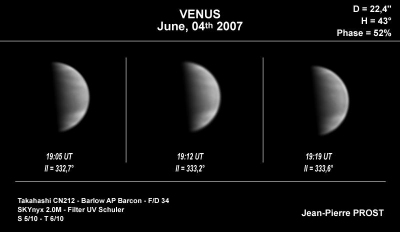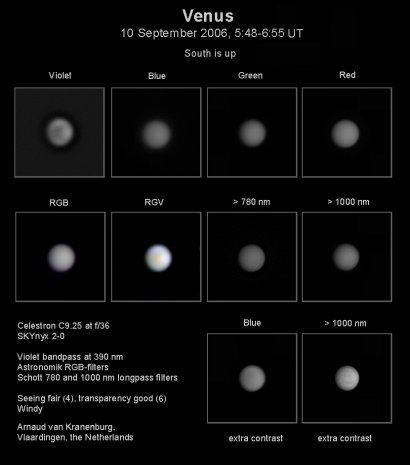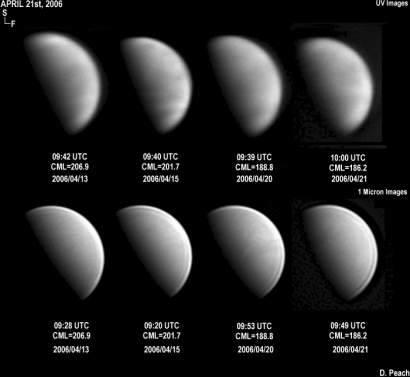Venus Amateur Observing Project
Introduction
The Venus Amateur Observing Project (VAOP) is an opportunity to contribute scientifically useful images and data to complement the Venus Express (VEX) spacecraft observations of Venus. The project will focus on utilising the capabilities of advanced amateurs to obtain images of the atmosphere of Venus; specifically filtered monochrome images obtained with CCD based cameras in the 350nm to 1000nm (near ultraviolet, visible and near infrared range).
The Venus Express (VEX) spacecraft will observe the planet Venus using seven instruments for at least two Venusian years (1000 days) beginning in May 2006. The instrument package includes the Venus Imaging Camera (VMC), which will image the planet in the near-UV, visible and near-IR range. Although VMC will provide much higher resolution images of the planet than visible from Earth, continuous monitoring of the planet will not be possible.
There may be periods, therefore, when parts of the planet are visible from Earth that are not visible from the spacecraft (due to the spacecraft position in orbit). Additionally it is important to compare Earth-based observations with simultaneous spacecraft observations. In particular this will allow us to extend our understanding of the dynamics of Venus’s atmosphere based on the VEX data to observations made prior to the VEX mission, as well as after completion of VEX operations.
Objectives
The objectives of VAOP is to obtain high quality images of Venus before, after and during VEX operations. Amateur astronomers, using CCD based cameras with filters for specific band passes in the near ultra-violet, visible and near infrared wavelengths (350nm to 1000nm), are encouraged to participate in the gathering of images. Observation campaigns will include:
- Routine images of Venus during each apparition
- Coordinated observations during specific periods of the VEX mission to provide either simultaneous or complementary ground based images to VEX spacecraft observations
Submission of Images
Details on how to submit your observation results are given in the related article "Submission of Images" linked from the right-hand navigation.
Professional Astronomers Coordinated Campaign
Parallel to the VAOP, multiple teams of professional astronomers join efforts in a coordinated campaign to perform ground-based optical through mm observations of Venus, during the period 23 May to 9 June 2007. Several of the teams will also make observations outside this period. For more details on this campaign see also the link to the "Coordinated Ground-based Observation Campaign" in the right-hand navigation.
Points of Contact
General Enquiries
Please use the Contact link in the page footer
Enquiries on Taking Observations
Detlef Koschny
Tel: +31 71 565 4828
Email: Detlef.Koschny esa.int
esa.int
Equipment
The following are suggestions for the type of equipment required to make useful observations as part of the programme.
Telescope
A high quality telescope at least 8" (20 cm) in aperture is required, especially for UV-filter imaging. This can be of any optical design, although good results have been obtained with commercial Schmidt-Cassegrain and long focal length Newtonian telescopes. For telescopes with glass lens or windows (refractors and SCT’s) some attention should be paid to the type of glass used in the lens, since this may result in significant attenuation in the UV part of the spectrum. This is also true for other glass elements in the optical train, such as Barlow lens.
Camera
Images can be acquired using either a high-quality monochrome CCD camera or a monochrome digital video camera (e.g. based on webcam technology). Colour CCD cameras / video is not suitable for this project since this limits the possibility to perform meaningful filtered images, particularly in the near-UV regions. Some examples of camera's successfully employed for Venus imaging include:- Atik Instruments ATK-1HS or ATK-2HS
- Lumera LU075M
- Modified Philips Toucam camera with a monochrome CCD chip
Filters
To perform worthwhile imaging of Venus a core set of three filters are required:- U-Band filter (e.g. Johnson-Cousins photometric U-Band or Schott U-360, 300-400nm passband)
- V-Band filter (e.g. Johnson-Cousins photometric V-Band)
- I-Band filter (e.g. Johnson-Cousins photometric U-Band or an infrared custom-filter. In the case of non-standard infrared filters the cut-on wavelength and / or pass band should be noted)
- A photometric B-Band filter
- W47 or violet filter in combination with IR-blocking
- Photometric R-Band filter
- 850LP filters (850nm cut-on)
- 1000LP filter (1000nm cut-on)
Observing Guidelines
Venus is very bright, which permits very short exposures to be made in the visible & near infrared wavelengths with most telescope / CCD combinations. In the near UV, the combination of reduced CCD sensitivity and attenuation by the Earth's atmosphere requires longer time exposures. Nevertheless, exposures in the UV are typically less than 100ms for typical f-ratio used for planetary imaging.
The effective focal length of the instrument should be adjusted so that the image scale per pixel is approximately twice the resolution limit of the instrument (for example: if the resolution of the telescope is 0.5", then the image scale for pixel should be approximately 0.25"). The image scale can be calculated according to the following equation:
 |
Alternatively, the actual image scale can be measured from the image (e.g. by dividing the number of pixels the planet takes up on the screen by the angular diameter of the planet). Typically to achieve the necessary image scale (generally between f/20 to f/40) a 2x to 3x telenegative Barlow lens is required.
The image exposure should be adjusted to ensure a good dynamic range, without saturating the image. The optimal settings for each filter combination will need to be determined experimentally and will vary depending on conditions (for example transparency). For example with a 235mm SCT at f/35 an ATK-1HS camera at 10fps required 1/25s exposure for U-band, and 1/250s for V-band images.
Imaging should ideally be performed under good seeing conditions, although routine monitoring even during poor seeing conditions is often sufficient to record major atmospheric features. Venus is bright enough be observed and imaged in daytime when the planet is generally at higher elevations than during nighttime. Care should be taken that the telescope does not accidentally point at the sun during daytime observing. However, daytime seeing conditions can often be poor, especially if the telescope tube is exposed to direct sunlight. Often around sunrise and sunset seeing conditions can often be good.
Prior to making routine observations the imaging setup for Venus observations should be optimised by experimenting with camera settings, filter combinations and focal ratio.
The observer should be familiar with planetary imaging their instrument and camera. Sky & Telescope magazine (http://www.skytelescope.com) has published several articles on planetary imaging that may be of interest to Venus imagers:
- Davis, M., and Staup, D. (2003)
Shooting the Planets with Webcams
Sky and Telescope 105, 117-122 - Grafton, E. (2003)
Get Ultrasharp Planetary Images with your CCD Camera
Sky and Telescope 106, 125-12 - di Cicco, D. (2003)
The New Face of Planetary Astronomy
Sky and Telescope 106, 30-32 - Dantowitz, R. (1998)
Sharper Images through Video
Sky and Telescope 96, 48-54 - Shiga, D. (2004)
Amateur images Venus's surface
http://skyandtelescope.com/news/article_1266_1.asp
Taking Observations
Observing Logs
Key details of images must be recorded for the data to be useable. Therefore an observing log should be kept which records the following data:- Name of observer
- Observing location (latitude, longitude, height)
- Weather conditions during observation including cloud cover, seeing conditions, transparency, wind & temperature
- Telescope type, size, f-ratio
- Camera type
- Effective focal length of instrument while imaging, image scale per pixel, camera settings (gain, shutter speed, number of frames) for each filter
- Filter types
- Processing methodology (nature of image processing, including corrections & post processing)
- Image orientation (direction of celestial south & proceeding / following side of image)
Dark & Flat Fielding
Although many observers do not routinely perform dark & flat field correction to planetary images, the validity of images is improved using this method especially when faint atmosphere features are detected. Dark fields should be taken using the same exposure settings as for actual images, but with the optics covered to prevent light reaching the camera. For the exposures likely to be used for most Venus imaging dark current is unlikely to be a significant concept except for UV imaging where higher gain settings and longer exposures are necessary.Flat fields should be taken at approximately 2/3 the linear range of the detector chip. Flat fields can be taken either of the daytime sky, a white screen held over the telescope aperture or the inside of a telescope dome.
Image Processing
Image processing can be performed with a variety of freeware and commercial software applications. For digital video data the freeware Registax (http://registax.astronomy.net/) is a highly recommended tool for processing, since this permits automated selection, stacking & post processing of images. Additionally, dark & flat field images can be automatically subtracted from the video stream.Image processing should include selection of sharp individual frames from video, followed by alignment & stacking of individual images to reduce noise. Generally post processing using wavelets or unsharp masking is required to reveal fine detail. However, care should be taken during processing to prevent introduction of processing artifacts.
Digital Video Imaging
- Take dark field video
- Take flat field video with each filter
- Take images of Venus using filters, recording end time & duration of video acquisition
- Process video image sequences to yield high quality stacked images that are dark & flat field corrected
- Perform moderate post processing (wavelet processing of image)
- Annotate images with details of image, including filters, observing time
- Submit images to British Astronomical Association Venus Coordinators
Sample Images
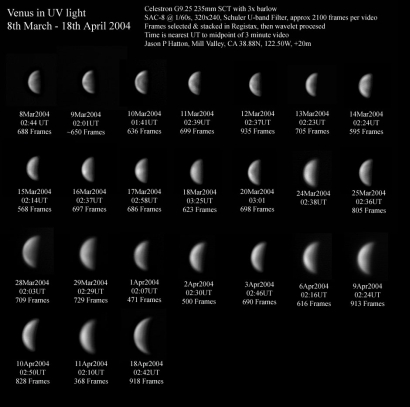 |
| Figure 1: U-Band filtered images of Venus taken using a 235mm Schmitt-Cassegrain SCT telescope and a SAC-8 CCD camera in video mode An example of routine monitoring of Venus, with images taken at approximately the same time of day between the 8 March & 18 April 2004. Changing cloud structure is apparent on the planet. The resolution of individual images varies from day to day due to differences in the seeing conditions (atmospheric turbulence). Over the course of the 6 week observing period the phase and apparent diameter of the planet changed significantly. All images by Jason Hatton (jason.hatton  esa.int) esa.int) |
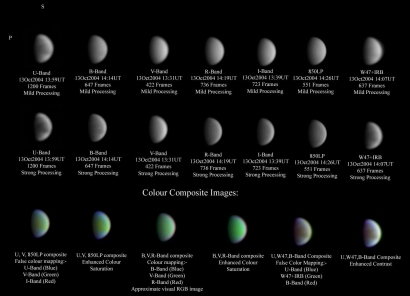 |
| Figure 2: Filtered images of Venus, 13 October 2004 A set of images showing the changing appearance of Venus at different wavelengths. Both the U-band (ultraviolet) and W47+Infrared blocking (violet) images show cloud structure, which is most apparent in the ultra-violet images. In contrast the planet was largely featureless in the visible and near infrared images. All images obtained by Jason Hatton using a 235mm SCT from Mill Valley, California (jason.hatton  esa.int) esa.int) |
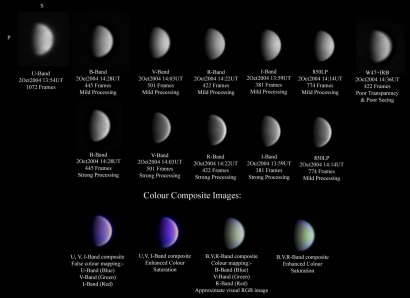 |
|
Figure 3: Faint markings detected in the infrared, 2 October 2004 |
Submission of Images
Venus ground-based image Active Archive
Amateur astronomers are invited to upload their original observation results of Venus in the central Venus ground-based image Active Archive (VAA). The VAA allows you to both upload and retrieve images and has been set up to collect images of Venus in such a way that they are useful for scientists (uncompressed images, no compositions). When used, your work will be mentioned and properly credited in the related scientific publications!
| Access the VAA at | www.rssd.esa.int/vaa |
Processed Images
In addition to the VAA, which aims for your original images of Venus (i.e. no mosaics or colour compositions), we also encourage you to submit your final processed results to the Venus section of the British Astronomical Association (BAA), coordinated by Dr Richard McKim.
| Email images to | Rmckim5374  aol dot com aol dot com |
| BAA Venus Section | http://www.take27.co.uk/BAA_MV/BAA_MVS.html |
Generally the BAA is accepting high quality JPEG images, with either annotation of details of the observation on the image or in an attached file. This should include the following information:
- Name of observer
- Observing location (latitude, longitude, height)
- Weather conditions during observation including cloud cover, seeing conditions, transparency, wind and temperature
- Telescope type, size, f-ratio
- Camera type
- Effective focal length of instrument while imaging, image scale per pixel, camera settings (gain, shutter speed, number of frames) for each filter
- Filter types
- Processing methodology (nature of image processing, including corrections and post processing)
- Image orientation (direction of celestial south & proceeding / following side of image)
To facilitate use of the images by the VEX team it is also preferable to have images in FITS format with all image details recorded in the FITS header.
Observing Campaigns
Routine Observations
Routine observations of Venus are needed throughout the period that VEX is observing the planet, as well as after completion of the mission. Since Venus has a high surface brightness it is potentially observable anytime it is far enough from the Sun to be safely observed. Here is a list of Venus apparitions from 2006 to 2011.
| Date | Event | Right Ascension | Declination |
| 13-01-2006 | Inferior Conjunction | 19h 38m | -15°56' |
| 25-03-2006 | West Elongation | 21h 21m | -13°39' |
| 27-10-2006 | Superior Conjunction | 14h 09m | -12°00' |
| 09-06-2007 | East Elongation | 08h 25m | +21°39' |
| 18-08-2007 | Inferior Conjunction | 09h 37m | +05°42' |
| 28-10-2007 | West Elongation | 11h 17m | +04°44' |
| 09-06-2008 | Superior Conjunction | 05h 10m | +23°00' |
| 15-01-2009 | East Elongation | 22h 54m | -07°21' |
| 27-03-2009 | Inferior Conjunction | 00h 13m | +10°22' |
| 05-06-2009 | West Elongation | 01h 52m | +09°00' |
| 11-01-2010 | Superior Conjunction | 19h 33m | -22°32' |
| 19-08-2010 | East Elongation | 12h 43m | -06°28' |
| 29-10-2010 | Inferior Conjunction | 14h 04m | -18°59' |
| 08-01-2011 | West Elongation | 15h 59m | -16°59' |
| 16-08-2011 | Superior Conjunction | 09h 44m | +14°59' |
Special Observing Campaigns
Coordinated observing campaigns in conjunction with spacecraft observations will be organised periodically. Information on observing campaigns will be posted on this site.
Useful Websites
Venus Ground-Based Image Active Archive
http://www.rssd.esa.int/vaa
British Astronomical Association Venus Section
http://www.take27.co.uk/BAA_MV/BAA_MVS.html
Association of Lunar and Planetary Observers (ALPO) Venus Section
http://www.lpl.arizona.edu/~rhill/alpo/venus.html
The website of Damian Peach (an experienced planetary imager)
http://www.damianpeach.com/
The website of Christophe Pellier (the first amateur astronomer to detect the 1μm emission from the night side of Venus). There is an excellent introduction (in French) to planetary imaging on this website
http://www.astrosurf.org/pellier/
Registax image processing software website
http://registax.astronomy.net/
A news article describing Chris Pellier's observation of the 1μm emission from the night side of Venus
http://skyandtelescope.com/news/article_1266_1.asp
List of all wavelength bands that allow observing features on Venus, compiled by Daniel Fischer
http://www.astro.uni-bonn.de/~dfischer/venus/
Giotto image processing software website (in German)
http://www.videoastronomy.org/giotto.htm
Results & Observations
June 2007
New views of Venus in the ultraviolet have been obtained by Jean-Pierre Prost, France, on 4 June, just a few days prior to Venus's greatest eastern elongation.
May 2007
With the currently favourable observing times for Venus a new set of images have been submitted.
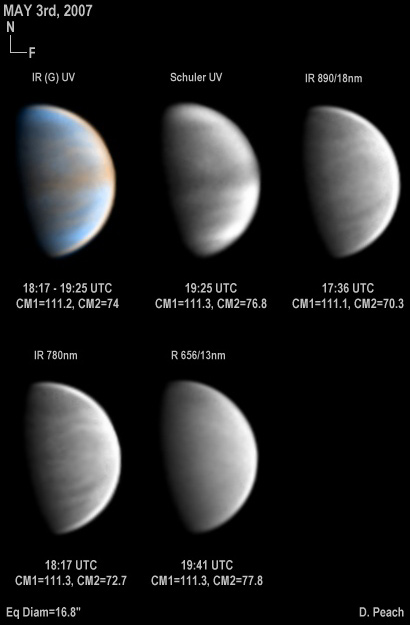 |
| Here are some images from 3 May 2007. Fair seeing. Some striking markings in the IR wavelengths. The dark equatorial band in UV is completely absent in the IR images. The 656nm narrow band image also shows the markings although they are very weak. Images by Damian Peach. |
March 2007
With the currently favourable observing times for Venus a new set of images have been submitted.
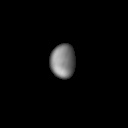 |
Date: 2007-03-15, UT: 18h20m - 18h40m Instr.: 16" Cassegrain f/10, prime focus Filter: Standard U filter Camera: FLI Dream Machine CCD camera with E2V sensor Observer: Detlef Koschny, Netherlands Sum of 90 images with 0.2 s exposure time each, stacked with Registax. South is up. |
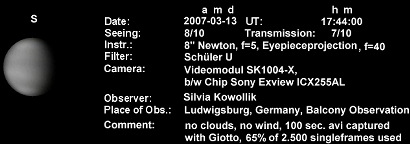 |
|
Venus observed by Silvia Kowollik from Germany |
September 2006
August 2006
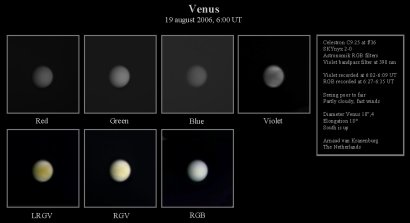 |
|
These views of Venus were obtained by Arnaud van Kranenburg on 19 August 2006, using a Celstron C9.25 telescope with a set of RGB filters (Astronomik) and a Violet bandpass filter at 390 nm. |
April 2006
The first images from observing campaigns are now available. Amateur observer Damian Peach acquired a series of images from Barbados at around the same time as Venus Express entered orbit around the planet.

